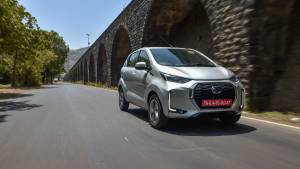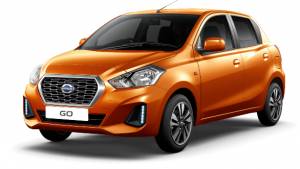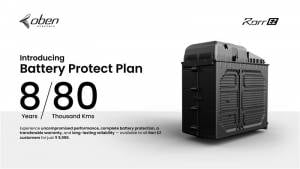Datsun Go vs Maruti WagonR vs Hyundai i10 in India
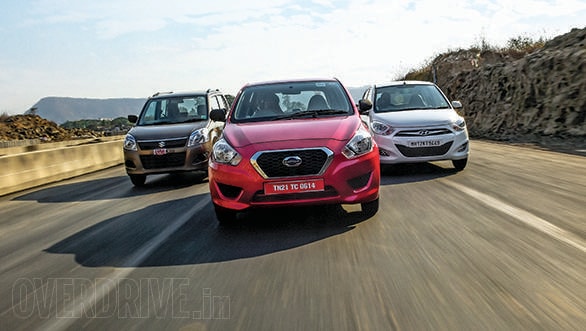
As you may have realised from our Hyundai Xcent vs Honda Amaze vs Maruti Dzire comparo, the compact sedan segment is fast gaining prominence over premium hatchbacks. But at a notch lower, the superminis continue to be an attractive bargain with their big space and small price. Case in point being the WagonR, which continues to be among the top sellers in the country with close to 15,000 units being sold every month. Most of these sales come from the LXi variant, which tells you that the `3.75 to 4-lakh bracket is the most popular. That is also the price point up to which the recently launched entry-level car, the Datsun Go, manages to stretch itself. Therefore, we decided to pit these cars in a comparison test, and to make things a bit more interesting, we also included the Hyundai i10* for a three-way battle.
*The Hyundai i10 Sportz pictures used here are only for representation. The car used for the comparison test was the Hyundai i10 Era
Design
The Datsun Go is the new face in the market but under the skin, it is a Nissan. The silhouette, however, isn't as bulbous. The Go has angular styling cues that are reflected in its chiseled headlights, boxy taillights, faux air dams and hexagonal grille. The rear three-quarter is the prettiest angle for this car with all the creases distinctly visible. The large wheel arches, though, make the Go appear under-tyred.
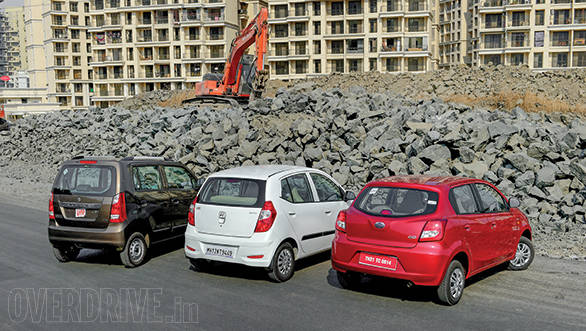
The case with the WagonR is similar but the lesser rear overhang helps reduce the imbalance. On the contrary, the front end looks too big and bulky for the rest of the box. The headlamps are too big like the eyes of an anime-character and the recent facelift only makes it worse with unnecessarily large grille and air dams. However, the large face and the bread-box silhouette gives the WagonR a perception of space, and that is one of the primary reasons why the tallboy is such a popular choice.
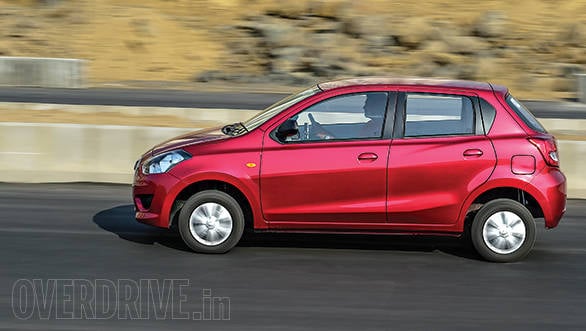 The Datsun Go under the skin is a Nissan Micra. The silhouette, however, isn't as bulbous
The Datsun Go under the skin is a Nissan Micra. The silhouette, however, isn't as bulbous
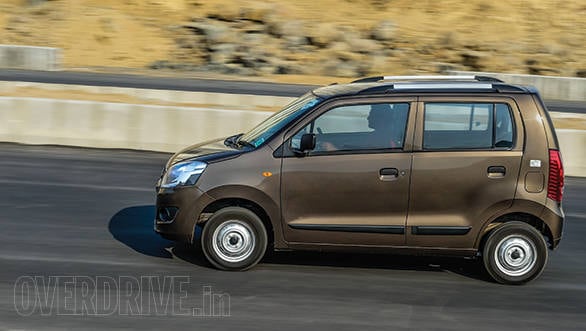 The large face and the bread-box silhouette gives the WagonR a perception of space, and that is one of the primary reasons why the tallboy is such a popular choice
The large face and the bread-box silhouette gives the WagonR a perception of space, and that is one of the primary reasons why the tallboy is such a popular choice
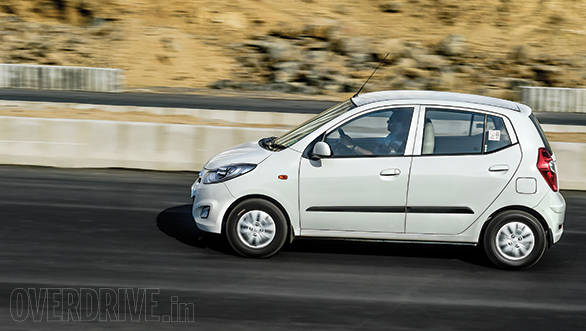 The i10 is a tallboy too, but also looks the most proportionate out of the three cars
The i10 is a tallboy too, but also looks the most proportionate out of the three cars
The i10 is a tallboy too, but also looks the most proportionate out of the three cars. The wheels fill up the arches quite well and are placed as close to the corners as possible, reducing visual overhang. Its hexagonal grille isn't as prominent as the Go, but the swept-back headlights with their complex detailing look more premium. The rear end, however, is flat like the WagonR with hardly any detailing.
Overall, the low-slung and wide body stance of the Datsun Go looks attractive and more imposing than the WagonR and i10, and that works in its favour.
Comfort and Convenience
The interiors of the three cars are in different leagues from each other. The Datsun Go is quite quirky in this regard. It begins with the front seat which at once looks like a couch from the Ambassador or Padmini. The seamless front seat is achieved by placing the gear shifter on the centre console and by incorporating a dash-mounted umbrella-type handbrake. The centre console also gets an audio unit that's similar in concept to portable speakers and only supports auxiliary devices ideally a phone or an MP3 player, that can be mounted on the swiveling dock and can be charged using the USB slot.
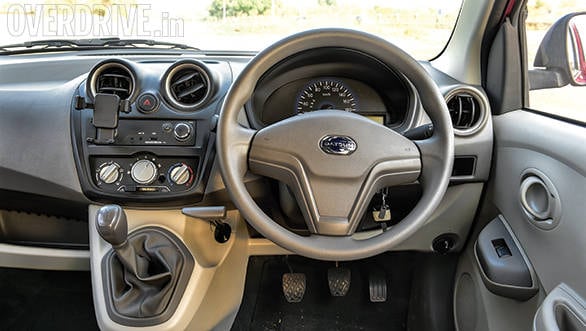 In Datsun Go, the seamless front seat is achieved by placing the gear shifter on the centre console and by incorporating a dash-mounted umbrella-type handbrake.
In Datsun Go, the seamless front seat is achieved by placing the gear shifter on the centre console and by incorporating a dash-mounted umbrella-type handbrake.
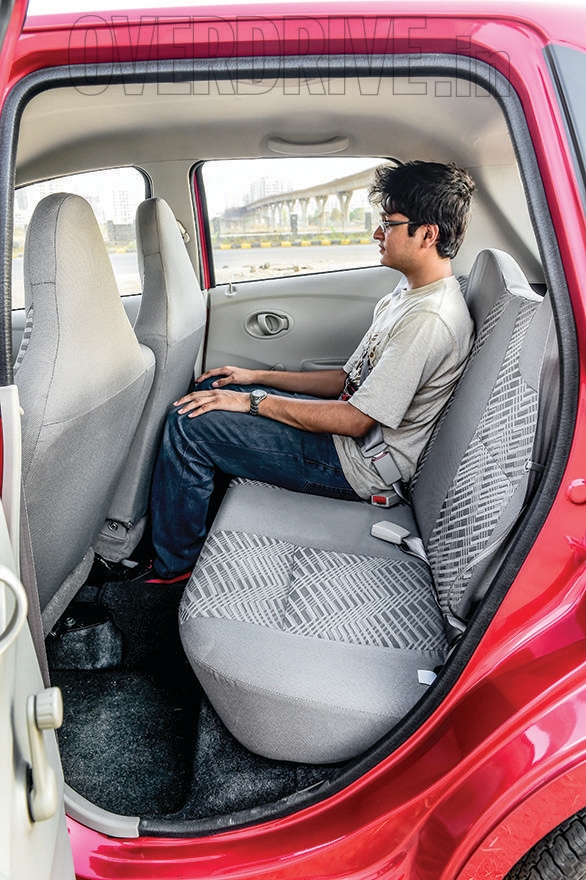 The Datsun Go rear bench has good under-thigh support
The Datsun Go rear bench has good under-thigh support
The oddness continues to the rear seats as the seatbelts aren't pre-tensioned. Instead they need to be adjusted manually like the strap on a backpack. Nevertheless, all the seats are well-cushioned and since both rows are essentially seamless benches, offers comfortable shoulder room for five adults. Headroom is decent, but the dipping roofline can make taller blokes feel claustrophobic. Ditto for kids, since the rising belt-line takes a toll on the rear windows.
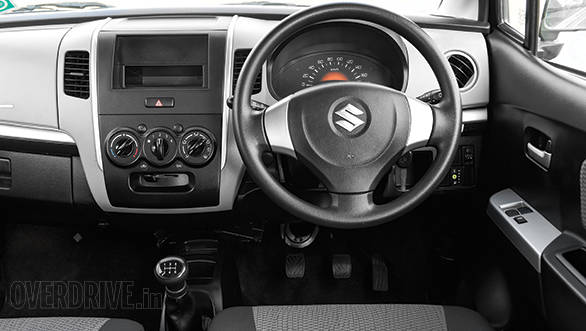 Black and beige interiors look good but plastics feel low-rent
Black and beige interiors look good but plastics feel low-rent
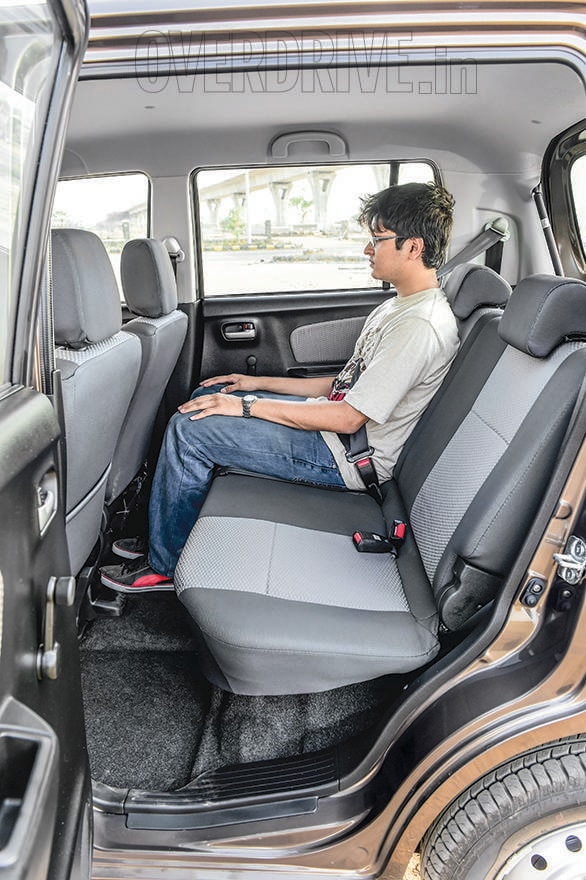 WagonR is most spacious out of the three.
WagonR is most spacious out of the three.
The case is similar in the i10 too. In fact, there have been so many complaints about the narrow rear windows of the i10 that Hyundai made sure that the glasshouse is airy for the succeeding Grand i10. While three adults can squeeze themselves into the back seat, the legroom makes things uncomfortable. Unlike the Go and the WagonR, the i10's rear seat doesn't get any headrests either. The front seats get integrated headrests, have adequate shoulder room and are contoured better than the Go and WagonR.
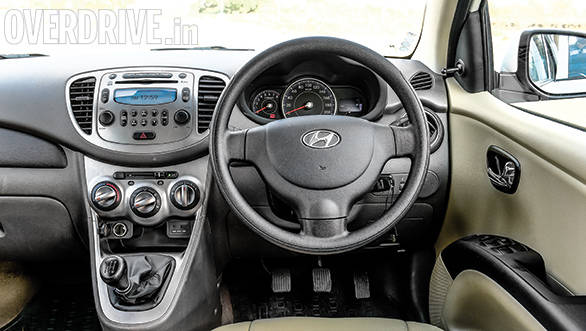
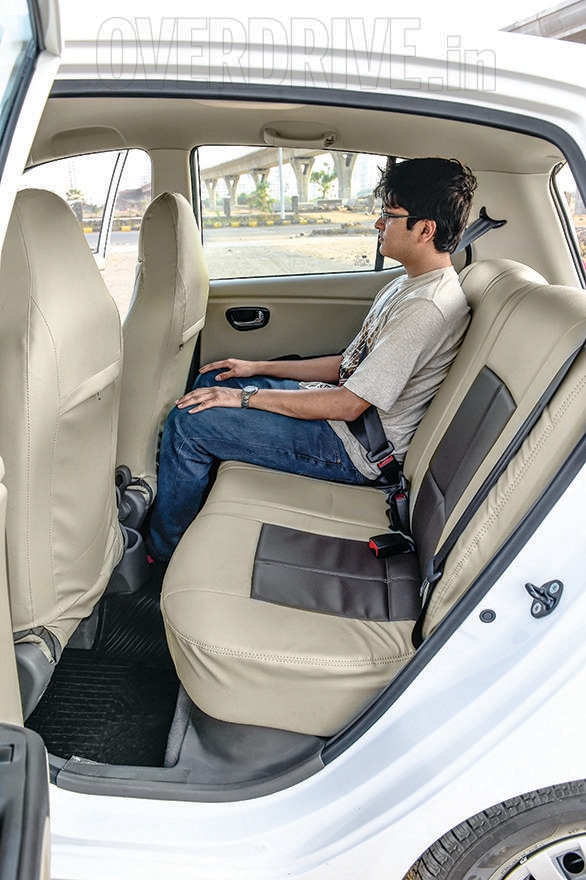 There have been so many complaints about the narrow rear windows of the i10 that Hyundai made sure that the glasshouse is airy for the succeeding Grand i10
There have been so many complaints about the narrow rear windows of the i10 that Hyundai made sure that the glasshouse is airy for the succeeding Grand i10
The dashboard is well laid out and the beige and brown colours make the cabin feel roomier than it actually is. The plastics are well put-together and their look and feel is better than in the other two cars. However, the i10 Era, being the base variant, loses out on an audio system and power windows. While you can invest in a good audio unit, an aftermarket solution for the latter is not recommended.
The WagonR, on the other hand, gets front power windows for the LXi variant. No audio system in here either. The dashboard is clearly the simplest of the lot, but worse are the plastics which look and feel low-rent. Where it scores though, is the seating. The boxy, tallboy design provides ample shoulder and headroom for five adults.
Performance and Ride Quality
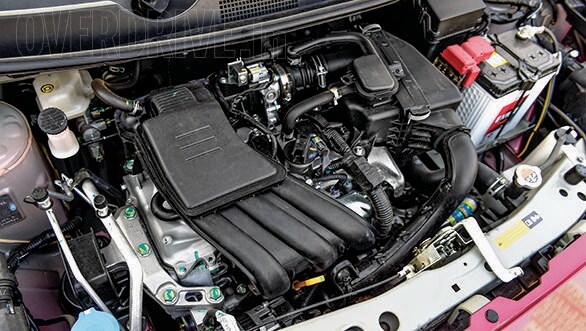 The Datsun Go has the largest engine of this test the Nissan sourced 1.2-litre petrol that produces 67PS at 5000rpm and 104Nm at 4000rpm
The Datsun Go has the largest engine of this test the Nissan sourced 1.2-litre petrol that produces 67PS at 5000rpm and 104Nm at 4000rpm
Let us begin with the WagonR since it has the smallest engine of the lot a 1.0-litre K-series petrol mill that is tuned to produce 67PS at 6200rpm and 90Nm at 3500rpm. After the launch of the Grand i10, the i10 is now sold only with the 1.1-litre iRDE2 petrol engine that puts out 68PS at 5500rpm with 99Nm of torque at 4500rpm. The Datsun Go has the largest engine of this test the Nissan sourced 1.2-litre petrol that produces 67PS at 5000rpm and 104Nm at 4000rpm.
The Datsun Go claims to be the most fuel efficient out of the three. In the real world though, the WagonR came out as the winner with an overall fuel economy of 18.8kmpl, followed by the Go at 18.4 kmpl and the i10 at 16.2kmpl.
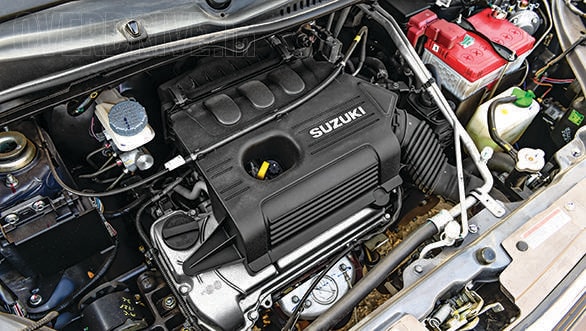 The WagonR since it has the smallest engine of the lot a 1.0-litre K-series petrol mill that is tuned to produce 67PS at 6200rpm and 90Nm at 3500rpm
The WagonR since it has the smallest engine of the lot a 1.0-litre K-series petrol mill that is tuned to produce 67PS at 6200rpm and 90Nm at 3500rpm
The Go's engine feels the most eager and also proves it with its 0-100kmph sprint time of 13.9s. The WagonR is the slowest with 16.2s and the i10 finishes second with 15.3s.
But that said, the Hyundai i10 feels easiest to amble around the cityscape. Its engine has a very good mid-range and a linear build up for power and torque. Overtaking is easy and so is getting a judgment of all the four corners of the vehicle. While the tiny bonnet is a dream for tackling tight spots, the long travel for the clutch and accelerator pedals can make it cumbersome in bumper-to-bumper traffic. On the highway, the i10 feels stable on straights but skittish around bends.
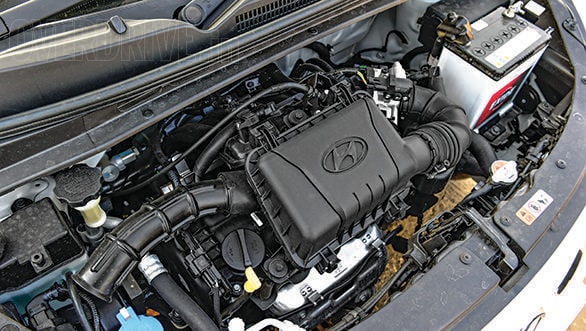 The i10 is now sold only with the 1.1-litre iRDE2 petrol engine that puts out 68PS at 5500rpm with 99Nm of torque at 4500rpm
The i10 is now sold only with the 1.1-litre iRDE2 petrol engine that puts out 68PS at 5500rpm with 99Nm of torque at 4500rpm
The Go, on the other hand, feels a tad jerky with its stronger low-end. The clutch is heavy and the pedal-travel for the accelerator isn't much and therefore takes time to get used to. Mid-range and top-end, however, are good enough even for highway runs but overtaking requires a downshift quite often. The Go also feels the most stable at highway speeds and under braking, while the WagonR is the worst. The Go handles corners better as well.
The WagonR carries out its urban chores with little room for complaint. The large glasshouse makes for easy judgment of the vehicle's dimensions and the engine has adequate power for city runs but doesn't feel as accomplished as the Hyundai. Like the i10 and the Datsun, the Wagon R too doesn't have ABS or airbags on any of its trims. There is plenty of body roll around bends and while changing lanes, thus making it unnerving.
Conclusion
Since these cars dwell in the price-sensitive segment, all three of them push the envelope with cost cutting. Maruti Suzuki relies solely on the economies of scale and therefore it manages to cut costs while maintaining the primary virtues of space and fuel economy that you expect from their products. Hyundai on the other hand has used time to its advantage. The ageing i10, with its global penetration, has reached a stage where it can be offered at a cheap price and that is precisely what Hyundai has done with its repositioning.
The Datsun Go follows a similar strategy by using the Nissan Micra's underpinnings to keep research, development and production costs low. This has not only helped in maintaining a low sticker price, but it has also given them a significant advantage in terms of space, equipment and performance. Despite that, it is also scores high on fuel efficiency and build-quality. Unsurprisingly then, it not only outshines its entry-level rivals, but also manages to steal the thunder from the two hatches that we have pit it against.
Starts Rs 3.99 Lakhs
1198cc
Automatic
68
104
19.59 Kmpl
Starts Rs 6.32 Lakhs
1498cc
Manual
90
200
21 Kmpl
-NA-
1086cc
Manual
-NA-
99
18.1 Kmpl
Starts Rs 5.73 Lakhs
1120cc
Manual
72
190
25.4 Kmpl
Starts Rs 5.4 Lakhs
998cc
Manual
56.69
77
26.2 Kmpl
Starts Rs 5.99 Lakhs
1461cc
Manual
64
160
23.08 Kmpl
